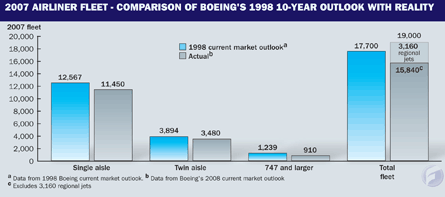While there are some areas where Airbus and Boeing concur on how the demand dynamics will play out over the next 20 years - such as in the twin-aisle category - these forecasts are ultimately an arm of their marketing programmes so are driven by each airframer's product strategy and throw up some significant differences in opinion.
A good example of this is the forecast for large airliner demand, where Airbus, with the all-new 500-seat A380 in its product line, has always been extremely bullish. The airframer's latest global market forecast predicts demand for 1,700 aircraft. Boeing, on the other hand - ever since it dropped plans for a major stretch of the 747 around a decade ago - has consistently put demand at fewer than 1,000 aircraft.
Boeing first delivered its current market outlook in 1964 and has been updating its forecast annually ever since. Airbus began publishing 20 year market studies in 1988 - which crystalised as its "global market forecast" in 1995 - but has not stuck to the annual publishing schedule of its rival.
The airframers' forecasters build a long-term model of demand based on individual airlines' network and fleet plans. A variety of sources feed into the final reports, including independent data and outlooks from trade organisations and analysts, as well as economic research on world and regional gross domestic product development to assess long-term traffic growth scenarios.
 |
|---|
While short-term shocks such as 9/11, last year's oil price escalation dramas or the current global financial crisis have some bearing on demand in the near term, the tendency is to assume, backed by historic prerogatives, that any impact will be ironed out and will not influence long-term trends.
For example, Boeing says in its latest current market outlook, produced amid the high fuel prices in 2008, that "the forecast has been developed in a manner that considers today's market environment, but takes a long-term view of the market and the fundamentals that drive commercial aviation. These include economic growth, world trade and new aircraft capabilities."
So how close have forecasts come to matching reality? Comparing Boeing's 10-year outlook published in its 1998 current market outlook for fleet growth from 1997-2007 with the actual fleet data included in its 2008 current market outlook indicates that its demand forecast was optimistic. The fleet (excluding regional jets) was expected to grow to 17,700 airliners in 2007, but the data in Boeing's 2008 current market outlook shows that the 2007 fleet was 15,840 units. However, in 1998, Boeing's current market outlook did not include regional jets - the boom was still in its infancy then. This category is now included, putting the total airliner fleet in 2007 at 19,000 units.
Significantly, back in 1998 when Boeing was still toying with ideas for a 500-seat airliner, it predicted that the fleet in this category would grow to 1,240 units, whereas in reality it would contract over the 10 years from 1,016 units to 910.
Airbus has traditionally stuck to taking only a long-term, 20-year view in its global market forecast, meaning that it is not yet possible to compare its 1997 view of the market with reality. However, it is worth pointing out that its 2003 global market forecast failed to predict the size of demand for the A380 from Emirates as it did not include the airline's Dubai base among its forecast of the top 10 large-aircraft hubs.
In the wake of Emirates boosting its A380 orders to more than 50 aircraft, Airbus quickly remedied this omission in its next global market forecast and now has Dubai placed third in the rankings behind London Heathrow and Hong Kong.
Source: Flight International



















